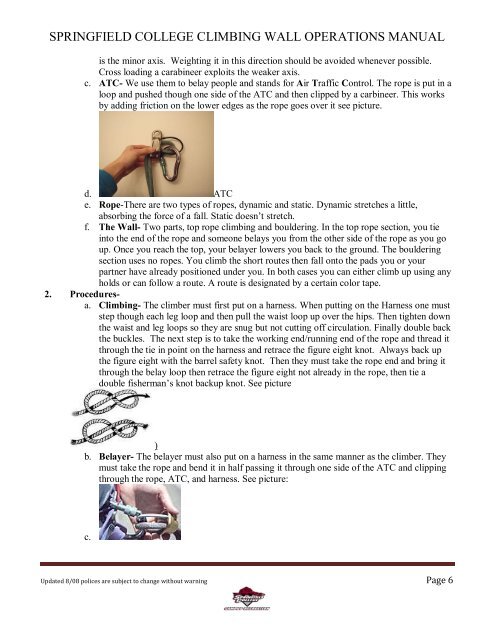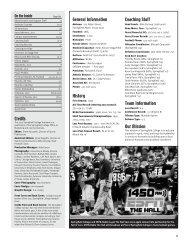CLIMBING WALL OPERATIONS MANUAL
CLIMBING WALL OPERATIONS MANUAL
CLIMBING WALL OPERATIONS MANUAL
You also want an ePaper? Increase the reach of your titles
YUMPU automatically turns print PDFs into web optimized ePapers that Google loves.
SPRINGFIELD COLLEGE <strong>CLIMBING</strong> <strong>WALL</strong> <strong>OPERATIONS</strong> <strong>MANUAL</strong><br />
is the minor axis. Weighting it in this direction should be avoided whenever possible.<br />
Cross loading a carabineer exploits the weaker axis.<br />
c. ATC We use them to belay people and stands for Air Traffic Control. The rope is put in a<br />
loop and pushed though one side of the ATC and then clipped by a carbineer. This works<br />
by adding friction on the lower edges as the rope goes over it see picture.<br />
d. ATC<br />
e. RopeThere are two types of ropes, dynamic and static. Dynamic stretches a little,<br />
absorbing the force of a fall. Static doesn’t stretch.<br />
f. The Wall Two parts, top rope climbing and bouldering. In the top rope section, you tie<br />
into the end of the rope and someone belays you from the other side of the rope as you go<br />
up. Once you reach the top, your belayer lowers you back to the ground. The bouldering<br />
section uses no ropes. You climb the short routes then fall onto the pads you or your<br />
partner have already positioned under you. In both cases you can either climb up using any<br />
holds or can follow a route. A route is designated by a certain color tape.<br />
2. Procedures<br />
a. Climbing The climber must first put on a harness. When putting on the Harness one must<br />
step though each leg loop and then pull the waist loop up over the hips. Then tighten down<br />
the waist and leg loops so they are snug but not cutting off circulation. Finally double back<br />
the buckles. The next step is to take the working end/running end of the rope and thread it<br />
through the tie in point on the harness and retrace the figure eight knot. Always back up<br />
the figure eight with the barrel safety knot. Then they must take the rope end and bring it<br />
through the belay loop then retrace the figure eight not already in the rope, then tie a<br />
double fisherman’s knot backup knot. See picture<br />
)<br />
b. Belayer The belayer must also put on a harness in the same manner as the climber. They<br />
must take the rope and bend it in half passing it through one side of the ATC and clipping<br />
through the rope, ATC, and harness. See picture:<br />
c.<br />
Updated 8/08 polices are subject to change without warning Page 6





